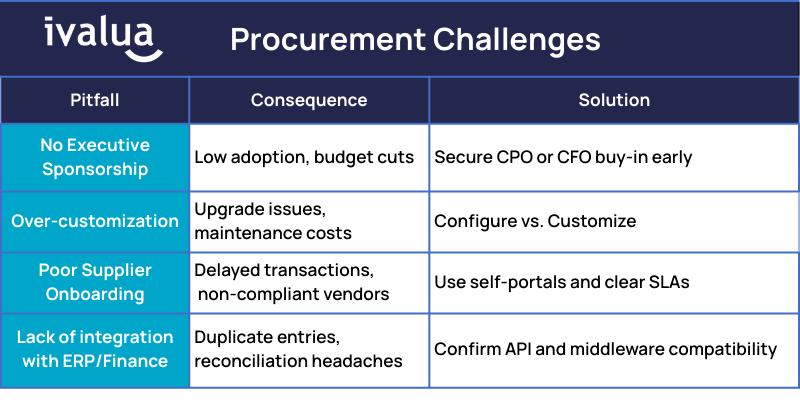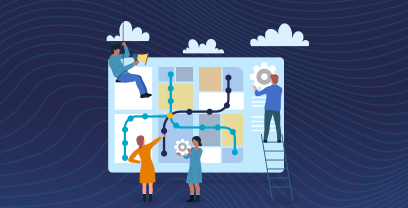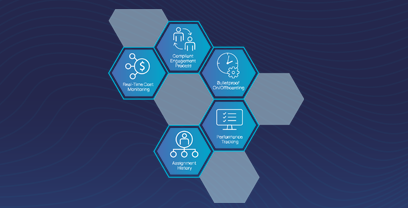Rising software costs, lack of procurement oversight, compliance headaches, and clunky vendor management. Sound familiar?
If you’ve been feeling the pressure, you’re not the only one. Many organizations are discovering that without clear procurement software best practices, costs spiral, risks multiply, and efficiency stalls.
At Ivalua, we’ve helped some of the world’s most complex organizations transform their procurement operations, giving us deep expertise in what works – and what doesn’t. In this post, we’ll break down proven strategies to help you streamline processes, improve visibility, and take back control of your procurement stack.
Learn how Ivalua can help you put procurement software best practices in place in your organization. Find Out More
What Is Procurement Software?
Implementing procurement software best practices begins with understanding the full scope of the Source-to-Pay (S2P) process – the end-to-end workflow that includes supplier management, sourcing, contract lifecycle management (CLM), purchasing, invoicing, payments and spend analytics. All of these processes are critical components for managing procurement activities strategically.
Modern procurement automation software helps companies to streamline repetitive tasks, improve cross-team collaboration, and improve visibility across every stage of the buying cycle.
Best-in-class e-procurement software typically includes modular capabilities that can be deployed separately, but work well in concert. Modules can include e-sourcing, contract management, supplier management, procure-to-pay (P2P), and advanced spend analytics. These modules work together to help organizations reduce risk and ensure compliance, while supporting data-driven decisions that lead to greater cost savings.
Selecting the best procurement software for your organization sets the foundation for long-term efficiency, transparency, and resilience across the entire source-to-pay process.
However, to fully realize the value of your investment, it’s critical to implement best practices that ensure your tools support both strategic goals and day-to-day execution. Next we’ll explore the top best practices to keep in mind when implementing procurement software.
8 Key Procurement Software Best Practices for 2025
Each of the following eight procurement software best practices are designed for optimizing the procurement process and helping you get the most out of your procurement platform to create a more agile and compliant procurement environment.
1. Establish Clear Procurement Policies and Compliance Standards
Without clearly defined policies and standards, procurement processes are inconsistent and error-prone. Building them into your procurement workflows helps to ensure they’re enforced automatically and at scale.
Start by defining rules for purchasing thresholds, approval workflows, preferred suppliers, and contract terms. Then, implement tools that automate those rules across sourcing, contracting, and purchasing activities.
Look for solutions that include embedded policy engines, automated audit trails, and risk detection to flag exceptions before they become compliance issues.
For example, organizations using platforms like Ivalua can configure automated workflows that enforce compliance based on spend category, supplier risk scores, or regional regulations. Additionally, analytics can help tobuilt-in Aanalytics I helps to identify outliers or contract deviations in real time so you can proactively manage risk while staying agile.
2. Centralize and Digitize Procurement Workflows
Siloed tools and fragmented processes make it nearly impossible to maintain visibility, control, or consistency across operations. In contrast, centralizing your procurement workflows with an integrated source-to-pay (S2P) platform is highly effective and improves efficiency while reducing risk.
Such platforms bring together sourcing, contract management, purchasing, invoicing, and analytics under a single unified system, where data flows seamlessly from one stage to the next. This allows you to standardize workflows and enforce policies, while benefiting from real-time collaboration across departments and regions.
For instance, teams that leverage Ivalua’s platform can manage the entire lifecycle of a purchase – from the initial request to the final payment – in one place. Built-in workflow automation routes approvals to the right people instantly, while eliminating manual handoffs that can lead to delays or errors. And, integrated dashboards give users visibility into status and spend at every step, helping teams stay aligned and accountable.
3. Build a Strategic Vendor Management Framework
Strategic supplier management is a critical opportunity to drive value. A strategic, scalable vendor management framework enables you to evaluate suppliers effectively and onboard them efficiently. Plus, it helps you to continuously monitor performance and unlock cost savings while building stronger partnerships.
A strong vendor management framework should be standardized, repeatable, and embedded into your procurement technology. Here are a few key components to focus on:
- Centralized Supplier Information Management: Start with a single source of truth for supplier data. With tools like Ivalua’s Supplier Information Management solution, teams can maintain accurate, complete records with automated validations, configurable onboarding workflows, and self-service portals for suppliers, ensuring data consistency from the start.
- Performance Evaluations & Scorecards: Set up regular performance reviews based on clear KPIs. Ivalua’s supplier performance management tools, for example, make it easy to build scorecards that track key metrics like quality, delivery, cost, and adherence to commitments. You can then track trends over time to guide renewal or exit decisions.
- Integrated Risk Management: Proactively manage supplier risk through continuous monitoring and real-time alerts. Solutions such as Ivalua’s Risk Center enable you to automate risk assessments while factoring in ESG criteria and geopolitical risk. It can even trigger workflows and smart alerts when thresholds are exceeded.
- Contract Lifecycle Automation: Use contract lifecycle management software that allows for collaborative negotiation and dynamic contract terms, so your processes adjust to align with evolving performance and risk profiles.
Combining these elements in a digital procurement platform will help you move from reactive to proactive vendor management and help you unlock more value from every partnership.
4. Leverage Generative AI and Automation for Procurement efficiency
Automation has long been a pillar of efficient procurement, but Generative AI is quickly redefining what’s possible.
Here’s what AI-powered procurement looks like in practice:
- Conversational Intake: As procurement’s reach continues to extend further into organizations, Gen-AI powered conversational assistants can simplify employee engagements with procurement by providing an easy, conversational experience that automatically converts requests into compliant procurement workflows, bringing more spend under management.
- AI-Powered Contract Lifecycle Management: AI can help speed up contract authoring cycle times by suggesting compliant, less risky language based on legal templates, previously agreed contract documents, and legal best practices. It can also provide better enterprise-wide visibility by extracting key information from contract documents for more complete reporting.
- Semi- and Fully-Autonomous AI Agents: AI Agents, powered by Generative AI, can execute tactical tasks within a defined set of guardrails. For example, AI agents can assist suppliers with routine onboarding tasks, or execute simple sourcing events to better manage tailspend. Allowing AI agents to manage these tasks frees up procurement’s time to focus on more strategic activities, while improving compliance and bringing more spend under management.
For a deeper look at how this works, check out Ivalua’s Generative AI for Procurement capabilities, which are fully embedded across the platform to support everything from sourcing to supplier collaboration.
Pro Tip: Want to see where AI is headed next? Download our Generative AI in Procurement Roadmap for a look at emerging use cases and practical implementation tips.
5. Enhance Spend Visibility and Cost Control
Disconnected systems and delayed reporting make it hard to track where money is going, identify savings opportunities, or flag spending that’s off-contract or out of policy. To stay ahead, you need dynamic tools that provide clear, actionable insights into spending patterns across the entire organization.
To that end, modern procurement software platforms should deliver:
- Real-Time Spend Analytics: Advanced analytics break down spend by category, supplier, region, or business unit – all the information you need to make informed decisions. Tools like Ivalua’s Spend Analysis solution automate data cleansing and enrichment, so you get accurate insights without the heavy manual effort.
- Collaborative Forecasting: Collaborative forecasting tools enable you to bridge the gap between internal demand forecasting and supplier capacity, ensuring sourcing plans are appropriate, suppliers will have capacity, and costly supply disruptions can be avoided.
Enhanced visibility allows for greater control over costs and reduces the chance of unexpected budget surprises. For a closer look at the impact of spend transparency, check out our blog on Business Spend Management.
6. Automate and Optimize Contract Lifecycle Management (CLM)
Automation significantly enhances contract lifecycle management by reducing manual effort and accelerating key processes.
With automated contract authoring, teams can quickly generate agreements using pre-approved templates and clause libraries, ensuring compliance and consistency while minimizing legal review time. Intelligent approval workflows further streamline the process by routing contracts to the right stakeholders based on criteria such as value, risk, or contract type.
Beyond execution, automation supports ongoing contract management through proactive tracking and risk control. Contract lifecycle management software with built-in alerts and dashboards can help you stay ahead of renewals and obligations, reducing the risk of missing deadlines or falling out of compliance.
AI-powered tools also flag unusual terms or potential risks throughout the contract lifecycle, so you can respond quickly and safeguard the business from exposure.
Pro Tip: Want to assess where your CLM strategy stands? Download the Contract Lifecycle Management Checklist to identify gaps and opportunities for improvement.
7. Streamline Cross-functional Procurement Workflows
Procurement doesn’t operate in a vacuum. To drive real business value, it must work in lockstep with IT, finance, legal, and other key stakeholders.
But in many organizations, siloed systems and disconnected workflows make that kind of collaboration slow and inconsistent, at best.
The key to streamlining cross-functional procurement is creating shared, transparent workflows that align teams around the same data and processes. This starts with intake management, a centralized, standardized request process that captures the right information upfront and routes it to the appropriate teams based on business rules.
With tools like Ivalua’s Intake Management software, you can:
- Collect structured intake requests across departments
- Automatically assign tasks and approvals based on project scope or spend thresholds
- Enable real-time visibility into request status and stakeholder responsibilities
- Foster accountability with shared dashboards and audit trails
By connecting procurement, finance, and IT workflows through a common platform, you’ll reduce delays, avoid redundant work, and ensure procurement is strategically aligned with broader business goals.
8. Measure Procurement Performance with Key Metrics and Benchmarks
High-performing procurement teams track KPIs that reflect both operational efficiency and strategic impact. But too often, performance metrics are scattered across spreadsheets or outdated dashboards, making it hard to see what’s working – or what isn’t.
Modern procurement platforms automate data collection and deliver real-time visibility into key metrics, so you can make faster, data-driven decisions. For example, Ivalua’s Analytics and Insights tool enables you to track performance against internal goals and industry benchmarks with minimal manual effort.
What KPIs should you track? Here are some of the most essential types:
- Visibility: KPIs that provide an overall view of Procurement’s reach, such as Spend Under Management or Spend Under Contract.
- Cost Savings: KPIs that track raw cost savings across S2P, such as Savings from Sourcing, Contracted Savings, etc.
- Cycle Time: KPIs that track operational efficiency, such as Supplier Onboarding Cycle Time or Purchase Requisition to Purchase Order (PR to PO) Cycle Time.
- Compliance: KPIs that track organizational compliance initiatives, such as Percent of Suppliers Assessed for Risk, Percent of Spend Without a Contract, or Percent of Invoices with an Anomaly.
- Adoption: KPIs that track software adoption and signal effective enablement, such as Number of Monthly Users or Number of Active Suppliers.
By tracking these KPIs in an automated, centralized dashboard, you’ll gain the insights you need to continuously refine your procurement strategies and demonstrate results.
Pro Tip: Download Ivalua’s Spend Analysis Datasheet to see how advanced analytics can uncover savings opportunities and improve spend visibility.
Common Procurement Software Pitfalls to Avoid
Just getting software in place isn’t a cure-all. Procurement software needs to be used to its potential, and business transformation needs to go hand-in-hand with digital transformation. Here are some of the biggest potential mistakes to avoid when looking to use technology to transform procurement
Lack of Standardized Procurement Processes
Following inconsistent or ad hoc processes can lead to approval delays, data entry errors, and missed compliance requirements. Standardized workflows create clarity, enforce policy adherence, and improve accountability, resulting in a more efficient, scalable procurement strategy.
Poor Visibility into Software Adoption
In order for procurement software to impact change, it needs to be used. After all, the best workflows and automation cannot impact spend that isn’t brought into the system. Proper system adoption KPIs, backed by clear change management and a stakeholder support framework is needed to ensure software success.
Overlooking Compliance and Security Risks
Relying on spreadsheets or fragmented systems to manage contracts and vendors makes it easy to miss key regulatory obligations, security requirements, or renewal clauses. Automated compliance tracking and alerts improve audit readiness, reduce legal exposure, and help maintain a strong risk posture across the procurement lifecycle.
Ineffective Vendor Negotiation and Contract Management
When procurement lacks access to historical performance data or real-time contract visibility, negotiation leverage disappears. Centralized CLM systems improve transparency, ensure obligations are met, and help uncover cost-saving opportunities – strengthening vendor relationships while reducing risk and administrative overhead.
Siloed Decision-making Between Departments
Procurement outcomes suffer when IT, finance, and operations act independently. Misaligned priorities can delay purchases, inflate budgets, or introduce security risks. Collaborative workflows and unified data across departments break down silos, enabling faster decisions and more strategic, organization-wide procurement planning.
Failure to Leverage Data and Analytics for Procurement Decisions
Procurement teams often rely on intuition or outdated reports instead of real-time analytics, leading to missed savings and increased risk. Embedded dashboards and intelligent reporting provide the insights needed to forecast demand, identify trends, and support more strategic sourcing, budgeting, and vendor selection.
Pitfalls that Software Can Fix
In addition to the key pitfalls outlined above, the table below highlights several common traps that require attention beyond the procurement platform itself: You should still be aware of these challenges and take proactive measures to mitigate them.
Pro tip: Check out our guide on How to Choose the Right Procurement Software for expert tips on what features to prioritize or avoid, and how to make the best choice for your organization.

Procurement Software Best Practices that Drive Efficiency and Control
Implementing procurement software best practices involves building smarter, more connected processes – as well as implementing the right technology. From automation to analytics, each best practice improves processes to help reduce costs, boost compliance, and empower your team to make faster, data-driven decisions.
That’s why leading organizations are turning to Ivalua. Our unified platform that supports procurement software best practices while bringing together supplier management, contract lifecycle management, and spend analysis in one place – helping your organization stay agile and control costs across the full procurement lifecycle.
| Take the first step toward enhancing efficiency, reducing risk, and empowering your team by implementing Ivalua’s procurement software best practices today. Watch Demo |
FAQs about Procurement Software
What are the top best practices for using procurement software?
Focus on centralizing workflows, automating compliance, leveraging AI-driven insights, and tracking performance with real-time analytics. Standardized processes and strong cross-functional collaboration are also key to maximizing value.
How can I increase procurement software adoption across teams?
Opt for intuitive tools, align workflows with user needs, and offer targeted training. Building cross-functional buy-in early is essential. Learn more in our S2P Buyer’s Guide.
What KPIs should I track in procurement software?
Track metrics like cost savings, procurement cycle time, contract compliance, user adoption, and procurement ROI. These KPIs help measure efficiency, effectiveness, and the strategic impact of procurement.
How long does procurement software implementation take?
Implementation timelines vary based on complexity but typically range from a few months to a year. For tips on planning and accelerating your rollout, check out our S2P Implementation Guide.
What’s the difference between P2P and S2P software?
A procure-to-pay (P2P) solution covers purchasing through payment, while source-to-pay (P2P) includes sourcing, contracting, and supplier management as well. Read our blog, “Source-to-Pay vs. Procure-to-Pay: Understanding the Differences,” to learn more.
Further Reading
Blogs
- How to Choose the Right Procurement Software
- Procurement Transformation Roadmap: Driving Greater Productivity Through Digitization
- Procurement Automation: The What, Why and How
Guide




